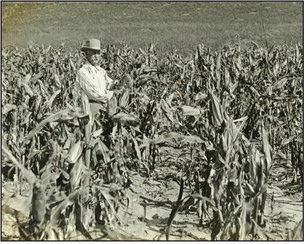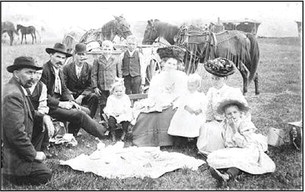Let’s Go, Cornhuskers! (Meaning Those Who Husk Corn)
Cornhusking was once considered almost a sport. There were cornhusking contests, and farmers “kept score” on the bushels shucked per acre per day.
Most of the crop was harvested in the field and called for extra hired men whose skill sometimes gained them a reputation well beyond their home communities.
J. D. Calhoun of the Lincoln Weekly Herald on December 3, 1892, reminisced about his “valuable and romantic experience as a corn shucker.” Calhoun, a former homesteader in Franklin County, recalled that he had “farmed and raised corn, and shucked it, and hired other men to shuck. We once hired one of those 100 bushels [per day] men and at noon he hauled up a consumptive looking load of stuff-with shucks sticking out of it like feathers on a ruffled pigeon—that might measure but could not weigh out 25 bushels. At night he would come in after dark with the same kind of a yield of his labor. He spent the evening around our hospitable fireside, telling how it was the hardest corn to shuck he ever saw, and how he had knocked out 100 bushels in a day for [neighbor] Dave Plasters the fall before. We let him go and got another man who held the championship belt of Atchison county, MO. . . . He shucked 60 bushels one day and then laid up for repairs with mutton tallow.”
Calhoun continued, “There is another queer thing about the cultivation of corn—the yield per acre. To hear men talk about their crops one would think the average yield to be 75 bushels. We remember once to have had by all odds the finest field of corn in the whole neighborhood for miles around. Nobody guessed it at less than 75 bushels per acre, and an editor made a note of it as promising 90. Everybody agreed that it was as good as had ever been seen in the county. Flushed with honest pride we measured that corn as it came to the crib, and it turned out just 48 l/2 bushels to the acre. And yet there were men in that neighborhood, nice men, real pillars of the church, who sturdily maintained that they hadn’t had an acre in corn that year which yielded less than 60 bushels. We wondered about it very much, but the next year a friend named Phipps explained the mystery.” When the expected yield per acre fell below projections, Phipps merely adjusted downward his total number of acres planted, and said, '"This year I sowed 35 acres of oats, but I find that I have only harvested 14. By that means I keep up my average per acre.’” According to the University of Nebraska’s Institute of Agriculture and Natural Resources, in 2016 Nebraska irrigated and rainfed corn yields averaged 199.9 bushels per acre and 147.2 bushels per acre respectively. That’s no tall tale, and today’s farmers are glad they don’t have to shuck all that corn by hand.
Picnic Mishaps
Picnicking is one of the most enjoyable summer pastimes, and Nebraskans more than one hundred years ago enjoyed it as much as we do today. Occasionally, however, these outings were marred by mishaps more serious than the presence of ants. The Omaha Daily Bee of Aug. 17, 1885, reported several unusual occurrences at the recent Union Pacific band picnic at North Bend. The Bee said:
"The train of 14 well-filled coaches left the Union Pacific depot [in Omaha] at 8:30 a. m. . . . The members of the band had considerable trouble when the train started, as it was discovered that suspicious persons were on board and that between 30 and 40 boys were trying to beat their way and were concealed John Nelson's photograph of picnickers, dating to 1907-1917, included several horses and two buggies in the background.
under the seats. The train was therefore stopped and the gang removed from the train. At Valley a little fellow was discovered riding on the trucks under the car. He was pulled out with his hat all in shreds and clothes badly torn.”
When the UP picnickers reached North Bend, they enjoyed a basket lunch and an afternoon of games, one of which caused injury to a bystander.
“Mrs. Lewis Stemm had a very narrow escape from what might have been a fatal accident. She was passing by the heavyweight striking machine, while the mallet was raised, and was struck on the side of the head. She was unconscious for a moment but was soon revived. A hammock was put up by the members of the band and the suffering woman was made as comfortable as could be done. The members of the band said after this they will never allow any more striking machines at their picnic.”
Another unusual accident befell a party of Albion picnickers in 1907. The Norfolk Weekly News-Journal of June 14, 1907, under the headline “Buggy Burns, Lunch Too," reported: "The most peculiar conflagration ever heard of happened in this vicinity. A fishing party given by Dr. and Mrs. L. E. Scouten,
in honor of Miss Vera Allen of Omaha, were enjoying the enticing pastime of landing the elusive trout and sunfish and were so engrossed in the pleasant pursuit that they were utterly unaware of the fact that the carriage in which they came to the brook was burning while standing with the horses hitched to it.
“After awhile the pangs of hunger drove the party to their base of supplies and when they arrived at where they hoped to partake of an elaborate out-ofdoor dinner, they found the feast in ashes as were also their carriage, wraps and bonnets. The faithful horses still stood hitched to the buggy tongue with their tails slightly scorched, but otherwise no worse for the fate that had overtaken the feast, the wraps and the carriage.”
The Osmond Republican website has been updated! Check it out at https://www.osmondrepublican.com

Cornfield near Ericson, Nebraska, 1910.








